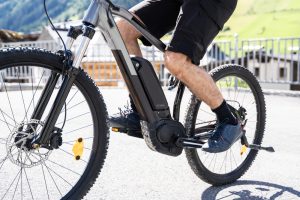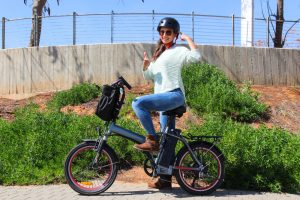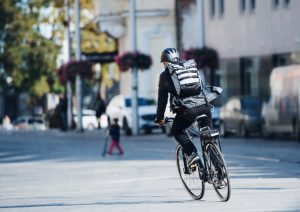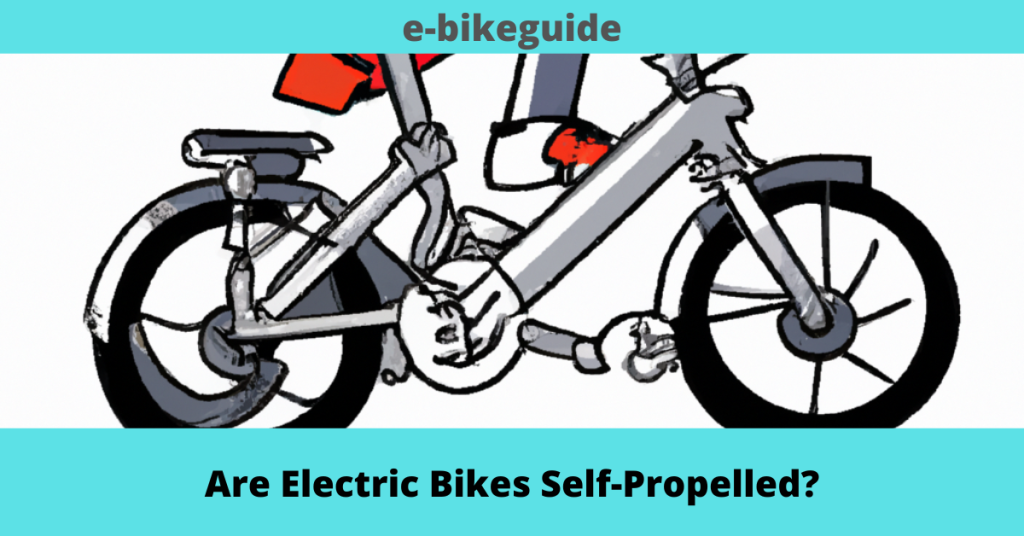Do Electric Bikes Move Themselves?

Self-Propelling vehicles use their energy to propel the vehicle forward by converting the energy. Au mobiles such as cars, trucks, tractors, airplanes, boats, etc., are examples of self-propelling vehicles. The e automobiles do not use external power like bicycles to move forward.
Traditional bicycles use human efforts to propel them forward. Electric bikes are also self-propelling vehicles when using the throttle. But also, they are power-assisted.
Class 1 electric bikes only use pedal assistance, and you must exert little effort to propel them forward. Therefore class 1 electric bikes are not self-propelling but power-assisted vehicles.
But class 2 electric bikes have a throttle option. You can use it to pedal with or without pedal assistance or throttle. And also, you have the option to propel the electric bike forward by powering the bike using both the pedal assistance and the throttle. Therefore, Class 2 electric bikes are self-propelling vehicles.
Class 3 electric bikes have pedal assistance, with or without a throttle. Therefore, Class 3 electric bikes can be self-propelling or power-assisted vehicles.
How does the throttle work on an electric bike?

Throttles are located in the grip of the handlebar of the electric bike. You can power up the motor by twisting or pushing it to propel the bike forward. It regulates the power of the motor using stored energy. Using self-propelling mode, you can have an effortless ride on your electric bike and relax your legs and joints.
The self-propelling option in electric bikes can come in handy when climbing hills. You don’t have to sweat anymore by pedaling and giving your best effort to climb steeper paths. Just twist the handle, and you can fast drive up the hill.
There are three types of electric bike throttles, each with advantages and disadvantages. Knowing the throttle will help you select the best suiting throttle to use on the self-propelling side of your electric bike.
Thumb throttle –A thumb throttle is a switch throttle that protrudes from the handlebar. Using your thumb, you can easily access it while gripping the handles.
It does not thwart brake levers or twist shifters. But it can slightly block the lever shifters, but you can correct it by pivoting the thumb throttle’s lever up and down.
They take up small space; therefore, you can have any handlebar option as it won’t affect the throttle. You also have the freedom to choose other handlebar accessories like mirrors and lights.
Thumb throttles are a better safety option, as you don’t face accidental encounters.
Major discouragement of using thumb throttle is weariness of the thumb. Though it might not sound like a serious problem, your thumb will feel numb when traveling a long distance, holding the lever from springing back. Unlike the other throttles, where the force spreads out to the whole hand, the whole force is controlled by the thumb. As a result, it numbs your thumb and exhausts it.
The grip on your handlebar is important to control the bike. When your thumb is busy pushing the throttle, you don’t have a better grip on your handle. In emergency times when you need full control of your bike, you will be elusive as to decide whether to hold the bike or still push the throttle.
In winter, your thumb will freeze with cold air rushing through the gloves on long rides. Though it is not serious, it can be numbing for a few hours.
-
Full twist throttle –
Full twist contradicting the thumb throttle takes up the handlebar, Leaving little to no place for handlebar end accessories. It requires all fingers with your palm to operate. Grabbing the throttle fully with your hand, you need to twist it towards yourself to make it work.
Full twist throttle is usually used in motorcycles and mopeds; therefore, the owners of mopeds and motorcycles will find it quite easy.
Due to the usage of the full hand, many people prefer this type of throttle. It raps the whole of the handle firmly, and you twist with your hand than just the thumb. The pressure is shared by the hand than just the thumb.
Using the wrist to hold the throttle can cause a sore wrist after a long ride. Just like you use the thumb to hold the thumb throttle, here you use the wrist to hold it in place. Thu b throttle gives you a sure thumb, while full twist throttle gives you a sore wrist.
The biggest disadvantage is accidental acceleration. It might be the case for beginners trying to get hold of it when in confusion might twist the wrist and crash. Unt l you become trained, this confusion might get you in trouble. If you accidentally bump into the wall, doors, or even other bikes might twist the handle and accelerate the bike.
As the full twist throttle takes up the whole space in the handlebar, using handlebar end accessories like mirrors and lights is nearly impossible.
-
Half twist throttle –
You can get what it means from the name, the half of full twist throttle. It is as same as its brother full twist throttle but does not take the whole handlebar. It takes up the first half of the handle, where it moves when you twist, and the other half does not twist. The non-twisting part is just a rubber handle on which your ring and baby finger rests.
The advantages of half twist throttle are the same as full twist throttle. Using your hand, you twist and hold it. But it is a safer choice than its brother, full twist throttle in accidental acceleration, and for practicing beginners.
As the throttle does not reach the end, you can avoid accidental damages; you have the other half that does not twist. Though it has chances of accidental acceleration, it is safer than the full twist throttle.
It also allows you to decorate the handlebar ends with mirrors and lights, as you have space.
You can also avoid wrist exhaustion as it has a solution to it. When twisting, you twist using only the thumb, index, and middle finger, and the other two fingers are at rest. With this arrangement, the twist doesn’t jump back to zero with the slightest loss of grip. This arrangement does not give tension to the wrist, and holding for a long period does not exhaust the wrist.
Long riding is not uncomfortable to the hand, and any finger doesn’t get sore after a long ride.
As we now know the throttle types available on the electric bike, you can choose the one that suits you best. Considering the pros and cons of the throttles, you can conclude what benefits are the ones you would like to enjoy by sacrificing a few of the other options. The throttles let us control the electric bike and make it self-propel without tiring our knees and joints.
About Push Throttle

Push throttle is a rarer and more dangerous type of throttle. It is a switch, and by pressing it, your acceleration is full; if you leave it, there is no acceleration. It is dangerous because it is on or off of full acceleration and nothing in between. The titles let you control the vehicle, but if they are in switch mode, it can be dangerous. Never try this push-button throttle on your electric bike.
Other throttle accessories.
Electric bikes, in addition to throttles in the handlebars, also have accessories. The most common are LED battery meters. It displays the battery level, normally in three colors: full charge partially drained battery and completely drained battery. These are inaccurate as it does not literally measure the actual battery level but the voltage level.
Lithium batteries have a constant curve on the voltage throughout their middle part discharge. Therefore, the LED battery meter is only accurate at the full and lower level of the battery. So if your battery indicates its fully charged, it is fully charged, and when it indicates that it is about to end, it is almost drained. But if you are guessing the middle discharge rate by following the lights, it can be inaccurate.
Many electric bikes have an on/off switch that would start the electric side of the electric bike. And there are a few switches that perform different tasks such as; lights, levels of pedal assist, cruise mode, etc. It also has switches that are held to work like; an electric horn and regenerative brakes, which only you need for a moment and not for a longer period.
Some bikes support keys using a key-lock system. It can be a safety am from the thieves trying to get to your bike. As it is easily accessible with on/off switch manufacturers, this option lets you switch on and off your electric bike with the key. Though you can also power up your bike with pedals, to get to the self-propelling mode of your bike, you have to have the key.
Electric bike self-propelling vs. power-assisted.

Electric bikes are a better option than traditional bikes and motorcycles. They have their features blended into one and provide a better service than the two. Traditional bikes are exhausting and make commuting a sweaty and energy-draining experience. In comparison, pedal-assisted electric bikes give you a sweat-free and refreshing commute to work. They are also with better features and options than traditional bikes.
Motorcycles can cut you low in your cash for the gas, while on an electric bike, you only need to recharge in place of gas, which is cheaper than gas. Not only does it cut the gas fee, but they are also lightweight and give you a noise-free ride. With more advantages than motorcycles, they are a better choice than motorcycles.
Electric bikes are a better option than traditional bikes and motorcycles; they have two main features; pedal assisting and throttle. What is the better option; riding with pedal assistance or self-propelling with a throttle? We will weigh their pros and cons, and you can decide which option is better.
Pros and cons of power-assisted riding mode.

Electric bikes are well known for their option, pedal assistance, which helps you give only a little effort to pedal and propel the bike. It only works when you start pedaling. You can choose the pedal assisting levels you want your electric bike to help you. You also can fully shut down the pedal assistance and rude it like a normal traditional bike.
Pedal assistance comes in handy when climbing steep hills, as a better and more relaxed way to commute, or you want to feel lighter when pedaling.
Pedal assisting bikes can be class 1, 2, or 3. All classes have pedal assistance in them. Depending on the speed limit, you will have legal rules on where to ride them.
Pros;
- To traditional bike users, this can be a better choice. With pedal assistance, you can choose the best suiting level of pedal assist in supporting your ride. When her, it is a gentle ride, leisure roaming, or climbing hills. This option will suit traditional bike lovers more than the throttle option.
- When using the throttle, you have to keep pushing the throttle to keep your electric bike moving. But in pedal assist mode, you can focus only on pedaling.
- The pedal assists electric bikes more efficiently than the throttle, as the electric bike design suits the pedaling most.
- In most places, pedal-assist bikes are allowed in bicycle lanes with a speed limit of 20mph. And the pedal assisting bikes, with a speed limit of 28mph, are allowed on roads in some states. Whi e throttle bikes are mostly discouraged on roads and bicycle lanes.
Cons;
- It can be a bad choice to ride in city limits as pedals assist bikes that don’t accelerate to the speed immediately but build up the speed through pedaling. Due to this, it can be a bad choice for slow peddlers too.
- Pedal assistance can tire your legs and joints even when you ride with pedal assistance.
Pros and cons of self-propelling riding mode.

Throttles are a simple way of propelling your electric bike forward. Like motorcycles and mopeds, when you twist or push the throttle, you engage it and propel forward. You can choose the acceleration to suit your riding by twisting it slower to harder.
Modulation in throttle means how smooth your throttle works. If acceleration starts at the burst and pushes you forward, your throttle modulation is poor. But if you can gain the acceleration little by little and control it, you have a good modulation. It means not all throttle are equally releasing the acceleration.
Pros;
- Using the throttle, you can jump to the acceleration point and start your bike at the speed you want, unlike pedal assist. It makes it a better choice to ride in cities and traffic.
- You can get an off traffic easier and swifter than pedal assists working.
- The throttle option is good for people with medical conditions that do not allow them to pedal or those who are not fit in shape.
Cons;
- It looks simple than it is. Poor modulation makes it harder to control the bike with a sudden outburst of speed.
- The throttle option can cause the drain of the battery level of your electric bike sooner.
. You can use both options in different situations, whether pedal assists or self-propelling in the electric bike. You can use pedaling when you are out and want fitness training. And use the throttle when you want to give a break to your legs. Both have their advantages and disadvantages. Use g it properly can give you an efficient ride.
Conclusion.

Electric bikes are self-propelling and, at the same time, power-assisted. Both options are available.
- Class 1 electric bikes are power-assisted.
- Class 2 electric bikes are power-assisted and self-propelling.
- Class 3 electric bikes are power-assisted and self-propelling.
But in most states and countries, only power-assisted class 3 electric bikes are allowed on roads.
Throttles are what make the power-assisted electric bikes into self-propelling electric bikes. By twisting or pushing the throttle, you can propel the bike forward. There are three electric bike throttles; thumb throttle, full twist throttles, and half twist throttles.
Most electric bikes have two options; to ride using pedals (power-assisted) or use throttle (self-propelling). Both features provide varying riding experiences. By weighing the pros and cons, you can choose what better suits your rides.
